The Building Management System (BMS system) and the practice of building automation in the age of IP, IoT (Internet of Things), big data, advanced analytics and hyper-connectivity. An intelligent and integrated building management systems evolution and solution overview.
Building management typically used to cover specific aspects of the management and efficiency of buildings overall. Yet, the building management systems market has been changing faster in recent years, with accelerating evolutions in intelligent and integrated building management systems as a result.
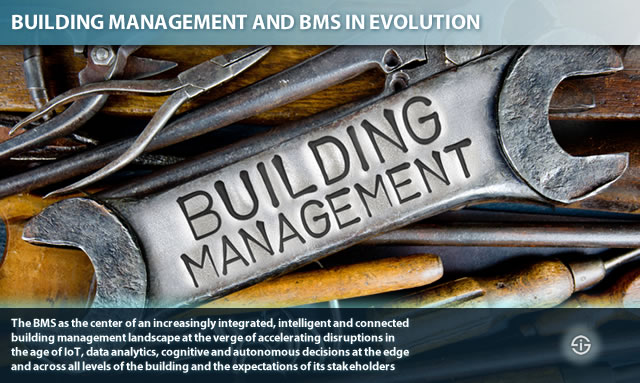
Today, we are amidst big changes once again and this time it’s highly transformational for the industry as IoT (Internet of Things), advanced analytics, artificial intelligence (AI), cloud computing and an increasing movement towards the edge (edge computing) and IP (Internet Protocol) are all essential drivers in an increasingly connected data age.
The essence of these changes: hyper-connectivity for integrated building management systems whereby the increasing connected role of the building management system (BMS) makes it take center stage again. And it’s not just about the fact that various other systems are being connected to building management systems as we’ll see.
As mentioned the role of IP and IoT, as well as related technologies and ever more data, is essential in these evolutions and continues to change the market.
The BMS market is expected to reach USD 19.25 billion by 2023
Moreover, we’ve only started to begin seeing what IoT and technologies such as big data analytics and artificial intelligence mean and will mean for building management and BMS in an increasingly intelligent buildings environment and ongoing hyper-connectivity. Myriad evolutions in the construction industry where we see the increasing importance of BIM (building information modeling), augmented reality, digital twins, and a range of emerging platforms, making the picture even more complex. And, of course, it all integrates with all the other technologies.
What is intelligent building management and why a Building Management System?
Before looking at the many evolutions in BMS it might be useful to first look at what a building management system or BMS is and why people also speak about intelligent building management systems and integrated building management systems as all these terms are used across this article.
Building Management Systems and Building Automation Systems
With its very long history and many evolutions, building management has its jargon and that does often lead to confusion.
The BMS is now the hub whereas before you could argue that it was the IT system that defined the criteria for the design of the building (Martin Feder)
You’ll also notice that some research firms look at the BMS market, while other focus on the iBMS market, for example. As the name indicates a BMS, short for Building Management System, is an integrated system enabling the management, control and partial automation of several building systems and functions.
The term BMS is often interchangeably used with BAS, short for Building Automation System.
It is also often interchangeably used with the acronym BEMS, standing for Building Energy Management System and with EMS, which stands for Energy Management System as we’ll see next.
A BMS is not an EMS or a BEMS but in the connected BMS energy is key
EMS and BEMS are also often used interchangeably but they are not the same. While there is a difference between BMS and (B)EMS this confusion is understandable given the evolutions in building management systems and the roots of building management systems.
As Martin Feder, who has been active in building management for over 3 decades and is responsible for the BMS certification badge of the EcoXpert partner program of Schneider Electric, reminds us in an interview on building management evolutions and drivers in the age of IP and IoT, in the really early days of building management the systems were called building energy management systems, so BEMS. However, as the building management market evolved, the ‘E’ of energy was dropped.
Yet, energy is now more important in building management again. That’s exactly part of the scope of this article in which we look with we look at how the BMS has become the center of building management and of connectivity with systems that include energy and so forth as Martin describes.
In a more recent interview, conducted end 2019, on building systems integration, Martin and Jeff Groat from US-based building automation integrator Wadsworth Solutions point out that in a fast-evolving landscape the role of BMS and integrators becomes even more important as we’re at an inflection point.
However, in the meantime the term BEMS has not just been the subject for many opinion pieces on the difference between BEMS/EMS and BMS but is also approached as a separate market and does come with different platforms and forecasts. To make things more confusing, instead of BEMS many also use the term EMS or Energy Management Systems, again distinguishing it from BMS.
The Buiding Energy Management Systems market is poised to reach exceed $13 Billion by 2026 (global revenue for 2017 was $4.0 billion) in the article mentioned below on BEMS that also covers the difference between Building Energy Management Systems and Building Management Systems from Navigant Research.
And what about power management? Quoting EcoXpert power management systems and advanced metering expert Kevin Morin from our interview on critical power buildings and power management in the connected age of IoT on what the BMS is about now: “Building management systems have the control of temperature/HVAC, primarily for comfort of occupants. Power management systems not only track energy performance of the BMS, they should also provide important insights into power distribution parameters throughout the building in both real-time and as a trend over time”.
The building management system and the intelligent building management system
A BMS is often defined as a control system, consisting of software, hardware and quite obviously communication protocols to control and monitor a vast range of building systems and controls.
Originally the number of building systems was quite limited and somewhere around the eighties integration started and the BMS became an integrated BMS for integrated or intelligent building management. In many definitions of a BMS you will find that it’s not just an – obviously computerized – control system but an integrated control (and monitoring) system and you’ll encounter another acronym as well: iBMS or IBMS standing for, you can pick intelligent or integrated BMS.
The concept and view of the intelligent building and intelligent building management really has to do with the convergence and integration of information technology (IT) and the increasing usage of analytics and actionable data as enabled by IP and more IT-oriented systems and information-intensive applications and technologies within the BMS space several years ago. Integrated building management is overlapping but de facto is more used in a context of building management whereby building functions are integrated at the start.
In an age where the BMS is the center of connectivity in the building that will increasingly dominated by new connectivity technologies, IoT and intelligence gathered through more data and information sources (IoT and sensors are one thing, leveraging the intelligence another and more about intelligent buildings) these differences will only matter in the jargon of whomever needs it.
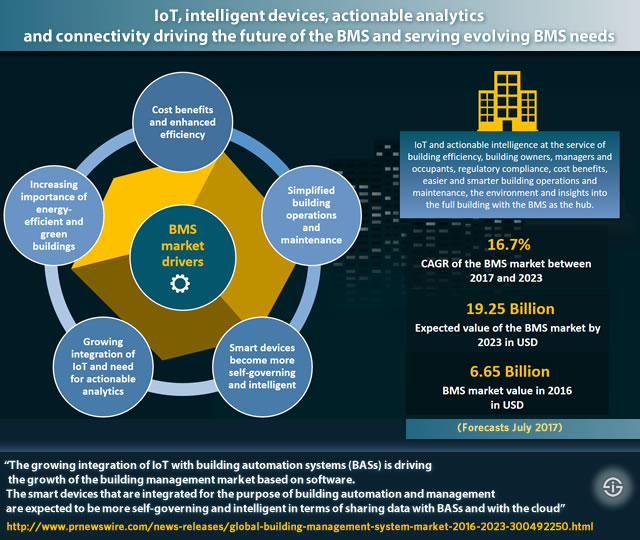
Intelligent buildings and smart buildings
When we talk about analytics, actionable intelligence, the Internet of things and artificial intelligence, which increasingly plays a role in the overall building and in IoT and big data as such, another term that inevitably pops up is the smart building.
As building management and the BMS evolve and change with the advent of IoT, AI and predictive analytics, and as the evolutions with regards to buildings are universal, discussions about differences between intelligent or smart buildings will soon be archaic or purely academic
Smart is the term that seems to be loved by anyone active in IoT and analytics and other technologies in convergence and context: from smart buildings and smart offices to the smart home, smart cities and even smart hair dryer (which is not a joke but you can ponder why you would need one).
The difference between an intelligent building and a smart building today? Mainly age. We’ve been using the term intelligent buildings for a long time, smart buildings are more recent in our jargon. Some point to differences between both, among others with regards to the building controls and the presence (or not) of artificial intelligence, predictive analytics and more. Trust us, soon enough it will all just be intelligent building management or simply building management as the market evolves (fast) and integrated building automation case studies demonstrate the benefits without a focus on the jargon.
According to an update on global IoT investments until 2021, IDC forecasted investments of $40 billion for smart building technologies (whereby the research company sees smart building as a cross-industry IoT use case which makes the link between smart and IoT clear, even if IoT is simply also transforming BMS) for the current year (2017).
According to Navigant Research, the IoT market for intelligent buildings will exceed $22Bn in 2026. The drivers are obviously pretty similar to those in other building managament and building automation evolutions we cover below and with the findings of the industry experts mentioned in this overview.
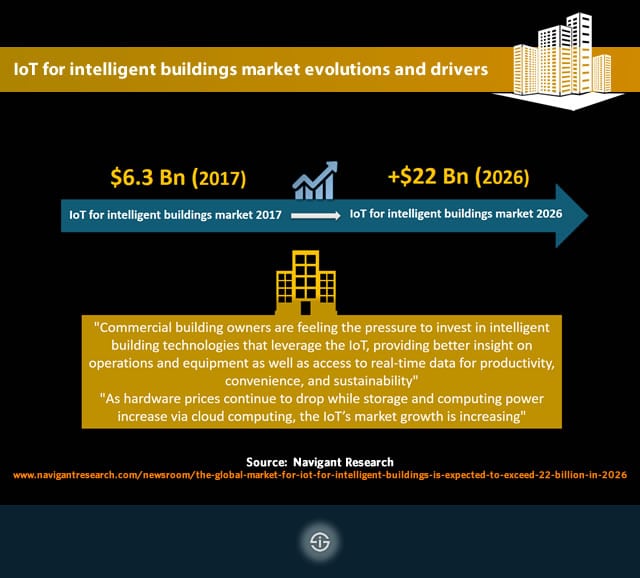
Building management systems: the center of the nervous system and brain of buildings
Whereas building management and BMS systems mainly used to look at the automation of building elements in the field of HVAC equipment, over the years they began to include lighting control, access control and so forth.
As the IT world entered the BMS space, the design of buildings became very much around network connectivity, yet as we’ll see that is changing.
Martin Feder puts it this way: “since more or less 2012 there is an increasing realization that the Building Management System is now actually the hub whereas before you could argue that it was the IT system that defined the criteria for the design of the building. Now, with among others the importance of energy, green building, the standards, the legislation and the many changes it’s become the BMS”.
And with the growing importance of energy, not in the least because of regulations, demand for eco-friendly buildings, and the role of energy, BMS systems in a way also moved back to their roots – as that’s what they originally were about, albeit a very long time ago. They arent’ about power management but increasingly connect with various systems, including energy. Martin describes how the BMS is taking center stage again as the hub of connectivity with other building systems.
Martin Feder: “The BMS has become the integration center of connectivity to other systems, including less obvious ones. It’s the integration center of connectivity to power, lighting, energy, lifts, and far more. You can even think about specfic systems in specific types of buildings such as acoustic systems in hospitals”.
Coming from a situation of proprietary standards, followed by rather slow technologies such as OPC (Open Protocol Connectivity), going hand in hand with developments on the level of networking technologies and IT as well as evolutions in building technologies, we can now speak about a genuine transformation in building management on various levels: the technologies, the disruptions in the market, the changes in customer expectations, the business models and the role of the BMS.
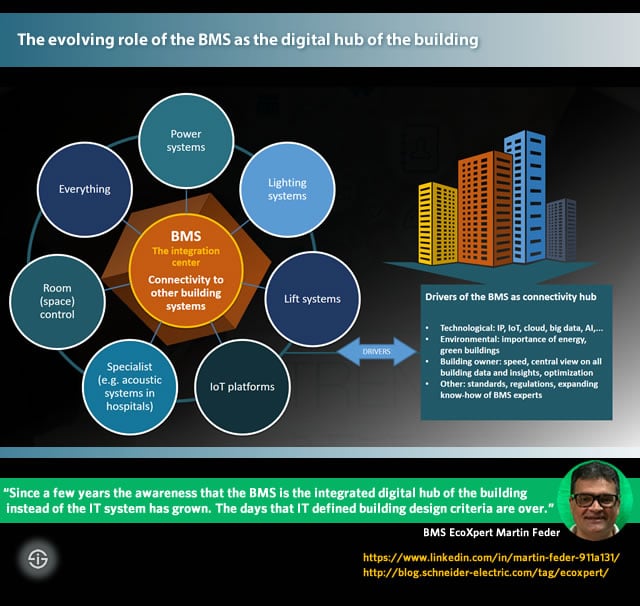
Integrated and intelligent building management, leveraging new technologies, protocols and intelligent solutions is the name of the game in which the building management system is the center of the building’s nervous system and brain in which the IoT, data analytics, cloud and soon AI and cognitive systems will play an increasing role as control devices in rooms and spaces move to the IP level as Martin Feder puts it in the previously mentioned interview on building management and IoT. Where is the IoT? Pretty much everywhere and soon at the edge and in intelligent autonomous decisions with the BMS as a visualization hub as well.
The factors driving the Building Management System to be the integrated center of connectivity in building management
The advent of IP about a decade ago and, more or less recently, the rise of the IoT (and cloud, big data analytics and other third platform technology realities), had and will continue to have a tremendous impact on the evolutions in building management and BMS as mentioned.
With the evolutions in IoT, artificial intelligence and cognitive, analytics at the edge (edge computing, fog computing) and more, the face of building management continues to evolve and the BMS increasingly takes center stage in the bigger building picture, beyond the traditional scope of BMS and in its connecting with several other systems and building-related areas.
The growing integration of IoT with building automation systems is driving the growth of the BMS market based on software
In the interview about building management systems and IoT, Martin Feder explained how IP and IoT are leading the market towards an integrated approach whereby the BMS is becoming the digital hub of buildings.
With changing expectations from building owners, the regulatory challenges which Martin mentioned (with the example of the – new – Energy Performance and Building Directive or EPBD and Switzerland’s energy consumption taxation model) and the increasing focus on ecology with more attention for building certifications such as LEED, building management professionals are pushed to this integrated approach whereby the BMS has become the integration center of connectivity to other systems in all possible areas within the scope of the building (such as lighting, energy, lifts, you name it).
This is even more the case if we look at the distribution of intelligent technologies at the edge whereby the BMS becomes far more important. And it also forces building management professionals to look at the building overall, instead of only the BMS part as traditionally was the case.
It is exactly what is happening and what is taught in the BMS partner certification program of EcoXpert.
Intelligent technologies and hyper-connectivity: the distribution of intelligence and centralizing role of the BMS
The movement to IP and to IoT is far from finished. As Martin explained in the interview and as mentioned, there is an evolution towards autonomous decision making at the edge whereby field controllers and even small actuators are moving to the IP and IoT level at the edge.
The keywords here are obviously data and analytics in order to gain an end-to-end view and an increasing automation, autonomous decision making and gathering of insights and intelligence with the BMS as the hub in a far more holistic approach and IoT as a key driver.
So, while there is a decentralization as is typical in IoT with intelligence, analytics and the edge (you can again think fog computing and cognitive indeed), at the same time there is a centralization within the building management space whereby the BMS is the integration center of connectivity with it all and with several areas that are related to buildings but don’t fall under the traditional scope of building management as it used to be.
Evolutions in building management and building automation communications protocols
Traditional building automation communications protocols and standards which have moved to IP and thus enabled Internet connection, such as BACnet (BACnet/IP, BACnet/IPv6), LON (LON/IP) and KNX (KNX IP) have become almost global standards and one could even argue that BACnet/IP is almost the de facto standard Martin says, with many providers nowadays offering IP BACnet controllers.
In the BMS space, IoT will gradually replace traditional communication networks such as BACnet by web services and closely imbricate with Internet oriented languages for software customization (Jean Commeignes)
IP has been and still is a true game-changer in the building management and BMS market. What the future will bring for these building automation protocols is another question. In an interview on the role of IoT in light and room control (L&RC), Jean Commeignes, who is responsible for the L&RC partner certification and badge in the EcoXpert partner program, stated that he believes that in building management IoT gradually will replace the more traditional communication networks, including BACnet, by webservices.
Towards an even more integrated Building Management System
The move towards integration in buildings and building projects as such isn’t new. For a variety of reasons integrated building management systems, also called intelligent building management systems have become a standard.
Yet, in the current hyper-connected reality the move towards integration and mainly interconnectedness takes on a new dimension which is driven by the changes caused by the drivers which Kevin mentions and the various technologies whereby the Internet of Things and the possibility to gather ever more insights in a better, smarter, faster and cheaper way, joins the several reasons and causes of this evolution.
Moreover and as stated, it’s not just about the Building Management System as a digital hub alone, it’s also about having a far more holistic view at the building across all its aspects. We briefly touched upon some drivers above. Let’s take a more in-depth look and also tackle some research.
Drivers of the ongoing integrated/intelligent BMS approach
Among the more traditional drivers which have led to a more integrated building management approach and Building Managemen System view are:
Cost benefits, simplified building operations/maintenance, increasing demand for energy-efficient and eco-friendly buildings, and growing integration of IoT drive the BMS market
- The role IT started to play and most of all the mentioned advent of IP.
- The increasing maturity and interaction possibilities on the level of open protocols such as the ones mentioned.
- The sheer possibility to add intelligence and higher degrees of automation across several aspects of the operation of the building.
- The need to reduce costs by having a more holistic view, hand in hand with the value of the building (with peer pressure being an element in larger companies).
- The growing awareness with regards to ecology and need to cut on carbon emissions and so forth, among others driven by regulations such as the mentioned EPBD. According to Navigant Research (October 2017) the market of energy efficient technologies in Europe alone is worth $83.5 billion.
- Regulations as such, beyond the aspect of ecology and with strong differences per country and also a focus ongreen building certifications such as LEED (and the value they add to the building).
- A growing focus on that overall value of a building whereby integration, technologies, ecology and a changing building market all play a role.
Drivers of the Building Management System in the age of IoT and digital transformation
While many of these drivers still remain important (reducing utility costs in the building, more efficient management, intelligence, building value and, most important of all nowadays, regulations) the possibilities enabled by IoT, cognitive and so forth are added to more drivers such as:
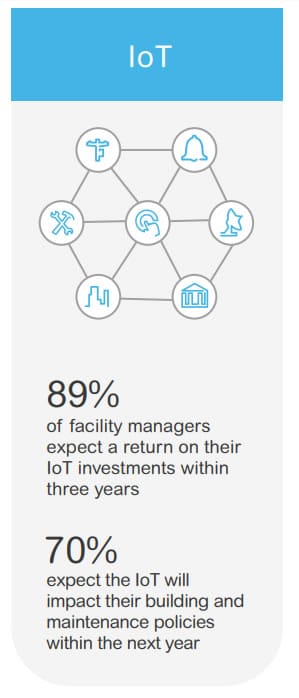
- Strongly increased expectations from both building owners and occupants. The impact of technologies such as cloud, big data analytics, mobile, new digital experiences/services and so forth have impacted all of us, regardless of our “role”. Describing all these changed expectations really would take an article on its own. We tackled some of building owners but also think about how the expectations of building occupants (and of regulators) impact those of building owners, which has the typical cascade effect of digital transformation: small and medium building owners want to save costs, meet regulation, be more efficient and enhance comfort of their customers, companies moving into large buildings have their expectations and are impacted by the expectations of their management and even workers, guests of hotels expect higher levels of comfort and control, the list is endless.
- The rise of IoT and the perfect storm of a convergence of new technologies enabling digital transformation and innovation drive the evolutions in BMS as well, how else could it be? These technologies don’t just make more intelligence possible, all the way to the edge of the building, they are replacing many standards and technologies as we know them now. Data analytics and decisions based on this data become autonomous on the field control level but in the end you always need that central hub.
- The decreasing costs of technology and of smart devices is a direct driver but also an indirect one as it has boosted the uptake of IoT and related technologies, within the building management space and far beyond. In industrial markets and critical power buildings where these technologies are increasingly embraced for myriad reasons, the building management aspects (e.g. factories and Industry 4.0) inevitably will fit in the broader picture of IoT and digital transformation.
- The increasing attention for smart cities as populations continue to rise and smart city visions are increasingly turned into action. According to September 2017 research by Navigant Research, smart buildings (which obviously need smart building management systems and are pivotal to make smart cities happen) in smart cities investments are expected to exceed $10 Billion by 2026. If we know that, as the press release states, buildings are responsible for around 30 percent of greenhouse gas emissions and 70 percent of energy consumption and look at earlier mentioned drivers the picture becomes clear.
- The attitudes of facility managers with regards to connected services. A survey among facility managers, conducted by Morar Consulting for Schneider Electric and unveiled in June 2017, found that 44 percent of facility management professionals expect investments in connected services overall to increase in 2017 whereby mainly managers of large buildings, the natural BMS market, see the benefits in connecting their systems to the Internet in ensuring smart, productive and profitable operations and to deliver better value and maximize energy. 70 percent of responding facility managers predicted that digitization and IoT would impact their building and maintenance policies within the next year.
The list goes on but there is little doubt to where it is all heading, which matters most in the end. Just as in the healthcare industry we see the role of EHR systems changing with big data, artificial intelligence and the IoT being integrated with it, the increasing usage and possibilities of the same technologies and, most of all their benefits and next level impact in building management, energy management, lighting and room control, etc. are making the BMS more than ever the digital hub of the changing building management reality.
Analysis, research and expectations regarding the evolutions and drivers of inteligent and integrated building management
The Internet of Things, cloud computing, (big) data analytics (BDA), fog computing and artificial intelligence further accelerate the evolutions in building management, always with the BMS as that mentioned hub and IoT indeed as a true building management game-changer as well.
Ample BMS market research shows that IoT and other technologies are among the key drivers of the industry and of BMS investments, obviously always within the context of all the other evolutions and drivers as we mentioned them and explore them more below.
IoT, self-governance and analytics at the service of BMS evolutions and demands
The convergence and integration of IT and OT, along with changing demands, is putting the BMS more central again (Martin Feder)
According to a July 2017 report on the BMS market evolutions between 2017 and 2023 for instance, the press release cited the growing integration of IoT as one of the major factors driving the market (poised to grow from USD 6.65 billion in 2016 to 19.25 billion by 2023 with an impressive compound annual growth rate of 16.71% between 2017 and 2023 according to this specfic research), along with important cost benefits, simplified building operations and maintenance, and of course growing demand for energy efficient and eco-friendly buildings, as known largely inspired by regulations but also by peer pressure and other factors as Martin pointed out.
The mentioned report also expects smart devices for building management purposes will become more self-governing and intelligent in terms of sharing data with building automation systems and the cloud. That intelligence won’t just happen in the scope of IoT, cloud and data sharing. It’s here in the scope of analytics and of cognitive as well. Convergence.
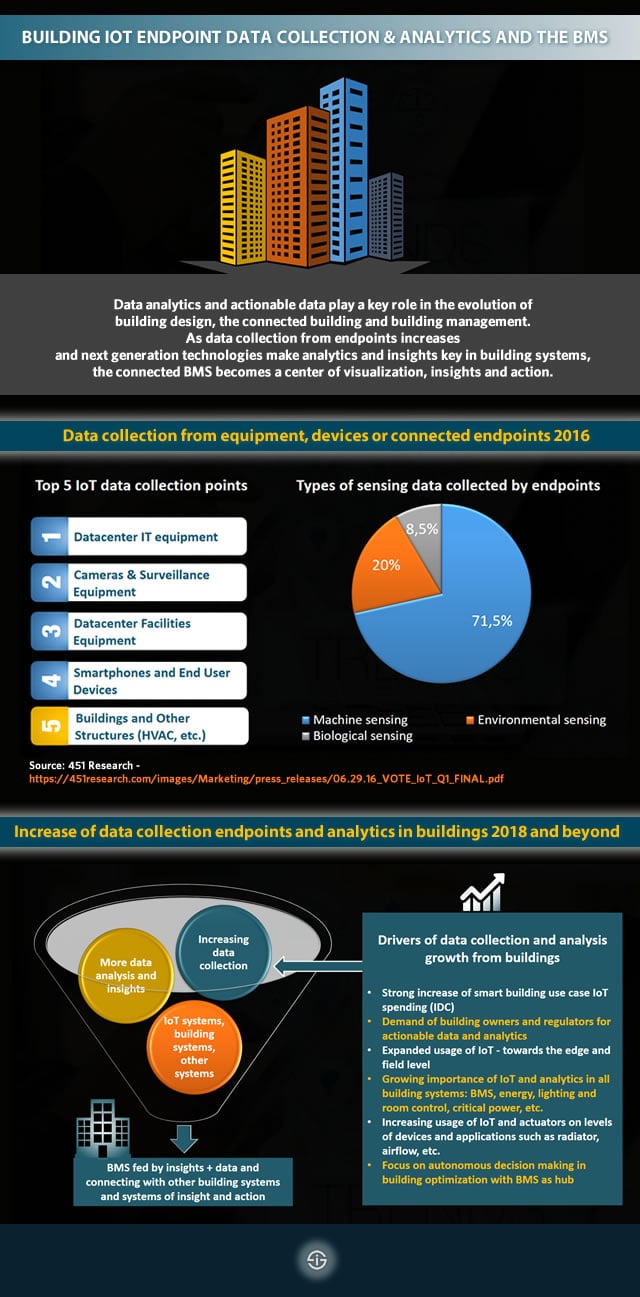
The leading and increasing place of connected buildings in IoT endpoints for data collection and analysis
The role of the Building Management System as the digital center of connectivity is not just strongly related with the increasing importance of data analytics and actionable data as such but also with the increasing data collection from equipment, devices and connected end points overall (both phenomena of course being intertwined).
As mentioned in an article on smart buildings, 451 Research found that data collection from buildings and other structures (including HVAC and so forth) ranked fifth in the list of equipment, devices or connected end points where data collection happens most.
It is preceded by respectively 1) datacenter IT equipment, 2) cameras and surveillance equipment, 3) datacenter facilities equipment and 4) smart phones and end user devices. You probably just read our thoughts: these are indeed all candidates for connection with the BMS or components which play a role in it. There are ample other categories where one might expect this, including environmental sensors, industry specific endpoints and more, further adding to the list of connected systems Martin Feder mentioned as depicted above.
It’s clear that, with smart buildings as a fast growing use case as mentioned earlier, IoT usage will become ever more important in a scope of building management, especially as connected buildings already are among the lead in IoT endpoints. To quote from the 451 Research press release, “Datacenter Equipment, Cameras and Surveillance, Smartphones, and Connected Buildings Lead IoT Endpoints”. Knowing that, as Martin also said, the field level is moving to IP and IoT and we are also moving to autonomous decision makers on the smallest levels of the overall building (actuators, sensors and so forth in a single building space or specific building system) it is equally clear that data collection at the connected building level (and, more importantly how it is used) will dramatically increase.
The integrated BMS market: evolutions and top integrated building management system vendors
There are dozens of vendors of integrated building management systems. Some vendors also has various solutions, depending on the type of building.
In January 2017 Technavio looked at the global integrated building management systems (iBMS) market with forecasts until 2021. The report also contains a list of 67 integrated building management system vendors that will play and impactful role in the overall market during the forecast period according to the research firm. Yet, let’s first take a look at the market predictions and drivers according to the company.
Integrated building management systems: segments and regions
The company expects the global iBMS market to reach a total value of $22.51 billion (in 2016 the market was worth $12.50 billion). The market value data are higher than those in previously mentioned building management system data. Yet, as per usual all depends on what is included and more.
Several start-up companies offering building integration software are venturing into the Integrated Building Management Systems market (Technavio)
The Technavio report looks at the overall integrated building management systems market, so not just the building management system software. As the graphic from the press release below indicates, the global iBMS hardware market is expected to reach $10.72 billion by 2021. The remaining part of the total $22.51 billion market in 2021 is for services and software, bringing us far closer to the previously mentioned research that looks at BMS software or Building Automation Systems alone. Also Technavio – how else could it be – points to drivers such as cost and energy savings and increasing awareness with regards to the benefits of effectively managing building facilities. Other factors include the flexibility which is provided by open iBMS solutions, enhanced productivity, enhanced security and higher ROI.
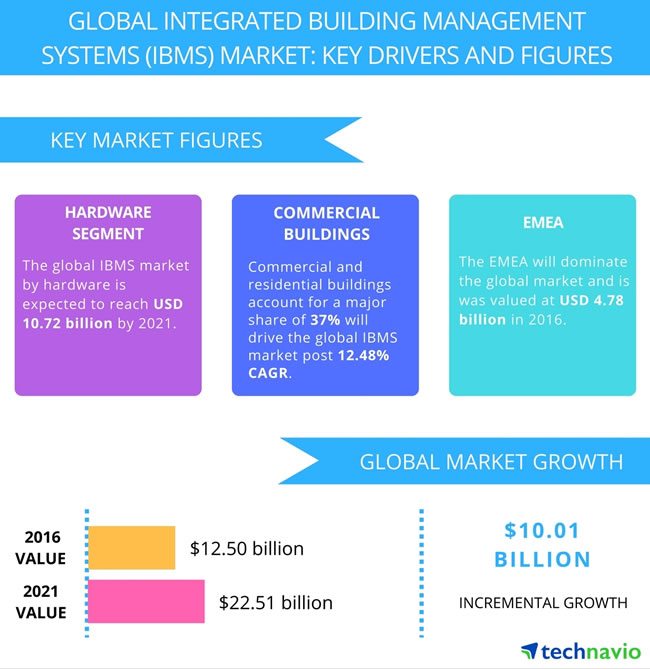
According to the graphic commercial and residential buildings account for 37 percent of the market and the EMEA region will dominate the global iBMS market. In 2016 that EMEA market was valued at $4.78 billion, more than a third of the global market.
The main drivers why the EMEA region will be the major iBMS revenue contributor:
- Growing awareness among end-users for optimizing their building automation systems and enhancing ease of operations.
- Growing demand in the MEA part of the EMEA region with increasing demand from African countries such as Algeria, Nigeria, and South Africa and Middle Eastern countries such as the UAE and Saudi Arabia.
However, the company also expects the APAC region to contribute the maximum revenue in terms of new business for integrated building management system vendors in a landscape where globally strategic acquisitions are to be expected whereby the large integrated building management system players seek regional partners who can help them in strengthening their local presences.
The major integrated BMS vendors and building management system solutions
Both the report from Technavio on integrated building management systems and the previously mentioned report on the evolutions of the BMS market sum up the top vendors in the market.
According to Research and Markets the key vendors in the building management system market are Honeywell, Siemens, Johnson Controls, Schneider Electric, United Technologies, IBM, Ingersoll-Rand and Delta Controls.
Technavio went a step further and made a list the top five vendors in the worldwide iBMS market with some explanations per vendor.
That top 5 is composed of Cisco, Honeywell, Johnson Controls, Schneider Electric and United Technologies. More in the list of intelligent building management systems and iBMS vendors below which starts with the 5 top vendors in the integrated building management systems solutions space and contains some more vendors of intelligent and integrated building systems (and links to their building systems) of prominent vendors, according to Technavio.
Ranked per region, Technavio has added iBMS vendors (on top of the 5 mentioned ones) such as:
- For the Americas: Advantech, Bosch, Building IQ, Building Logix, Control4, Convergentz, Delta Controls, Emerson Electric, Phoenix Energy Technologies, and Siemens
- For the APAC region: 3S Technologies and Automation, AllGreen Ecotech, Azbil Corporation, Bajaj Electricals, Cylon, Jardine Engineering Corporation, MS Group, NEC, Oberix, and United Technologies
- For the EMEA region: Advanced Control Solutions, Alerton, AMB, Armiti Trading, Atrina, Avanceon, Building Maintenance Services, Demont Engineering, Eagle Technology, and Giza Systems
Top image: Shutterstock – Copyright: EtiAmmos – All other images are the property of their respective mentioned owners.

